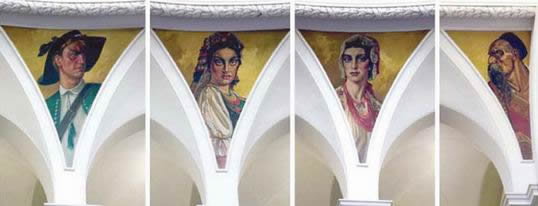
Mirko Racki, "Slovenian man, Serbian lady, Croatian lady, and Montenegrin man", 1937
On the walls of the Assembly there are twenty frescos, which were created in the course of 1937 by experienced masters of decorative painting and distinguished artists who were capable of painting on big formats and who had been elected at the open competition the previous year. Those in charge of monitoring the construction of the new edifice gave advice that the paintings should be thematically suitable for the purpose and that their style should be harmonized with the architecture and renaissance models, instead of relying on Byzantine heritage, cubism or expressionism.
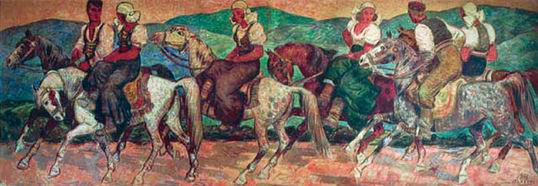
Vladimir Filakovac, "In the hills", 1937
The Great Allegory of Work, with the greatest dimensions, was painted for the small hall by M. Menegelo Rodic, famous for decorating the palaces of Split and the interior of public buildings. On the twelve pendetives in the same room, M. Racki, caricaturing persons, painted six female and six male portraits in the traditional clothes of the Yugoslav peoples of that time. He is an important representative of the secession and symbolism in the Croatian painting, known for his cycle of five great compositions about the life of Kraljevic Marko (1910). Three of them are kept in the National Museum in Belgrade, along with the drawing Liberation, which was a gift from the Federal Parliament (1959). T. Kralj, who acquired experience in painting churches on the Slovenian coast and in the surroundings of Trieste, was tasked to transfer the most splendid glorification of the fight for freedom which resulted in the union of Serbs, Croats and Slovenes, to the front wall of the Assembly's big hall.
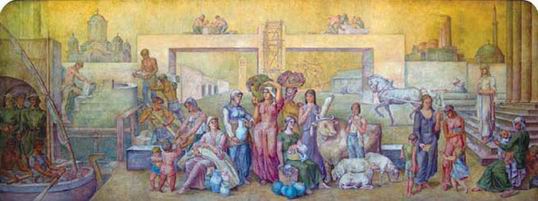
Mate Menegalo Rodic, "Big allegory of work", 1937
Somewhat small, but artistically closer to the contemporary times, are the frescos on the walls of the coffee club on the ground floor. Coast and In the Hills reflect the best poetic characteristics of the art of V. Filakovac, a distinguished Croatian artist and a professor at the Academies in Belgrade and Zagreb. There is also Gosposvetsko Field by R. Slapernik, the artist whose historical scenes decorate the public buildings in Ljubljana.
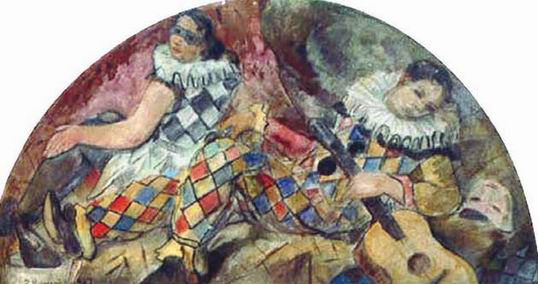
Rajko Slapernik, "Harlequin", 1937
In the restaurant, one level below, the same, well-known Slovenian artist, painted Harlequins and Feast in the manner of actual tendencies of poetic realism and modern concepts. Less known P. Petrovic Suhacev, one of the forgotten Russian immigrants in Serbia, painted Fishermen and Meal, somewhat anachronous and illustrative and relying on the experience of Luca Signorelli, as the members of the Reconstruction Committee recommended.
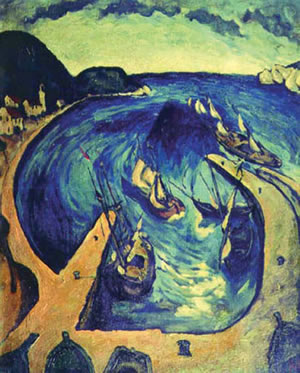
Ignjat Job, "Sea Motif", 1921
Canvas paintings and a small number of drawings and graphics are placed only in less available premises, because the most representative rooms (offices and conference rooms) are covered by woodwork and other decorative details. The nucleus of this segment of the parliamentary collection, which consists of ninety six pieces at present, were the portraits of the Chairpersons of the National Assembly. The first portrait was ordered in the mid-twenties from I. Tisov and another seven were ordered in the period from 1935 to 1939 from U. Predic, whose career was declining at that time, but who was still famous for his classical realistic skills. Judging by the years of creation, the works of the following artists were probably acquired in that period: S. Aralica, D. Glisic, P. Dobrovic, I. Job, M. Petrov, Z. Petrovic, V. Pomorisac, K. Hakman and S. Sumanovic-Serbian and Yugoslav mainstream painters. However, they must have been acquired only after the Second World War.
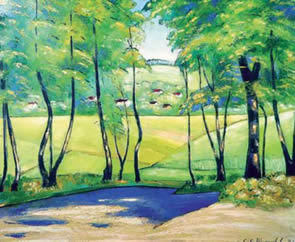
Sava Sumanovic, "Landscape of Sid", 1938
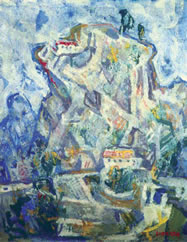
Petar Lubarda, "Landscape of Montenegro", 1949-1950
During the fifties and the sixties the works of the coryphaei from all parts of our common state during this period were placed under the parliamentary roof where they still remain. Those artists are: Dj. Andrejevic Kun, D. Antic, J. Bijelic, J. Bifel, S. Bogojevic, L. Vujaklija, V. Dimitrijevic, B. Ilic, V. Jordan, D. Kondovski, M. Konjovic, M. Kujacic, M. Kurnik, L. Licenoski, P. Lubarda, P. Mazev, M. B. Kiar, P. Milosavljevic, M. Milunovic, P. Omcikus, S. Pejovic, O. Petlevski, Dj. Popovic, M. B. Protic, I. Radovic, F. Filipovic, S. Hodzic, I. Seremet, F. Simunovic and S. Sohaj.
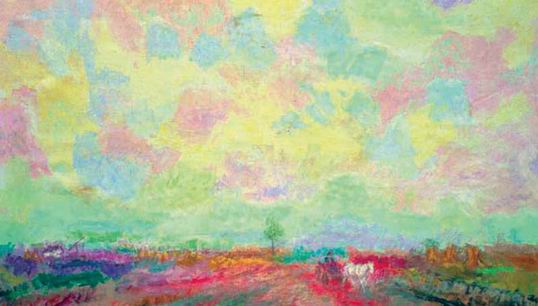
Ivan Radovic, "Vojvodina Motif", 1950s
The collection encompassed one hundred and fifty six pieces of art, out of which sixty were stolen or destroyed in the fire on October 5, 2000. Among them there were some very valuable works created by our imminent artists: S. Aralica, B. Dogan, P. Dobrovic, M. Kecic, M. Konjovic, P. Lubarda, M. Makanec, P. Milosavljevic, M. Milunovic, Z. Petrovic, Dj. Popovic, Z. Prica, M. B. Protic, V. Svecnjak, B. Stevanovic, I. Tabakovic, M. Todorovic, V. Filakovac, M. Celebonovic, B. Sotra, M. Sustaric, etc. Although the loss is irretrievable, very soon after the event, the Ministry of Culture of the Republic of Serbia donated thirty nine paintings, three sculptures and one tapestry to the Assembly. These are the works of contemporary authors: B. Damjanovski, V. Dunjic, Z. Djak, Lj. Jankovic, A. Lukovic, B. Miljus, B. Mihailovic, P. Omcikus, Lj. Popovic, R. Reljic, M. Skovran, V. Stanic, M. Stankovic od Macve, T. Stevanovic, Z. Stojanovic, U. Toskovic, M. Tucovic, A. Cvetkovic and others. In that way the collection continued to enhance and its artistic value is the obvious evidence of creative achievements in Serbia and the former Yugoslavia.
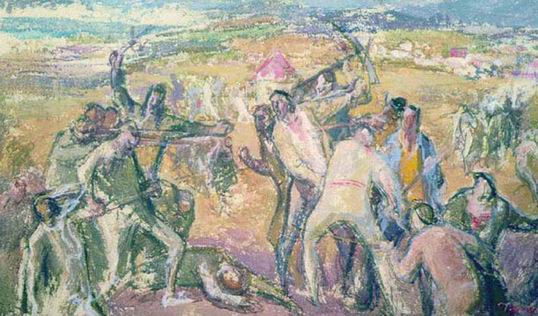
Ismet Mujezinovic, "Uprising of Husin Miners", circa 1957
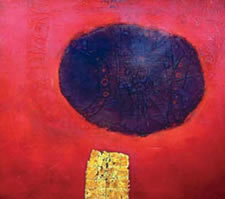
Mesko-Bogdan Kiar, "Umbel I", 1964
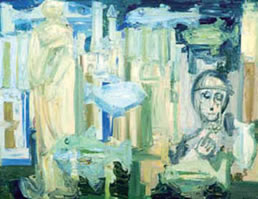
Peda Milosavljevic, "Dubrovnik", 1959
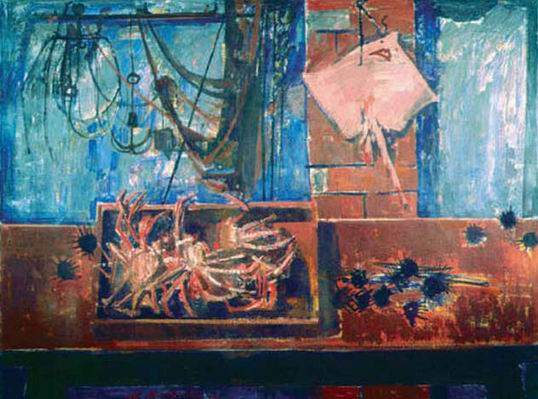
Milo Milunovic, "Big Table", 1958















